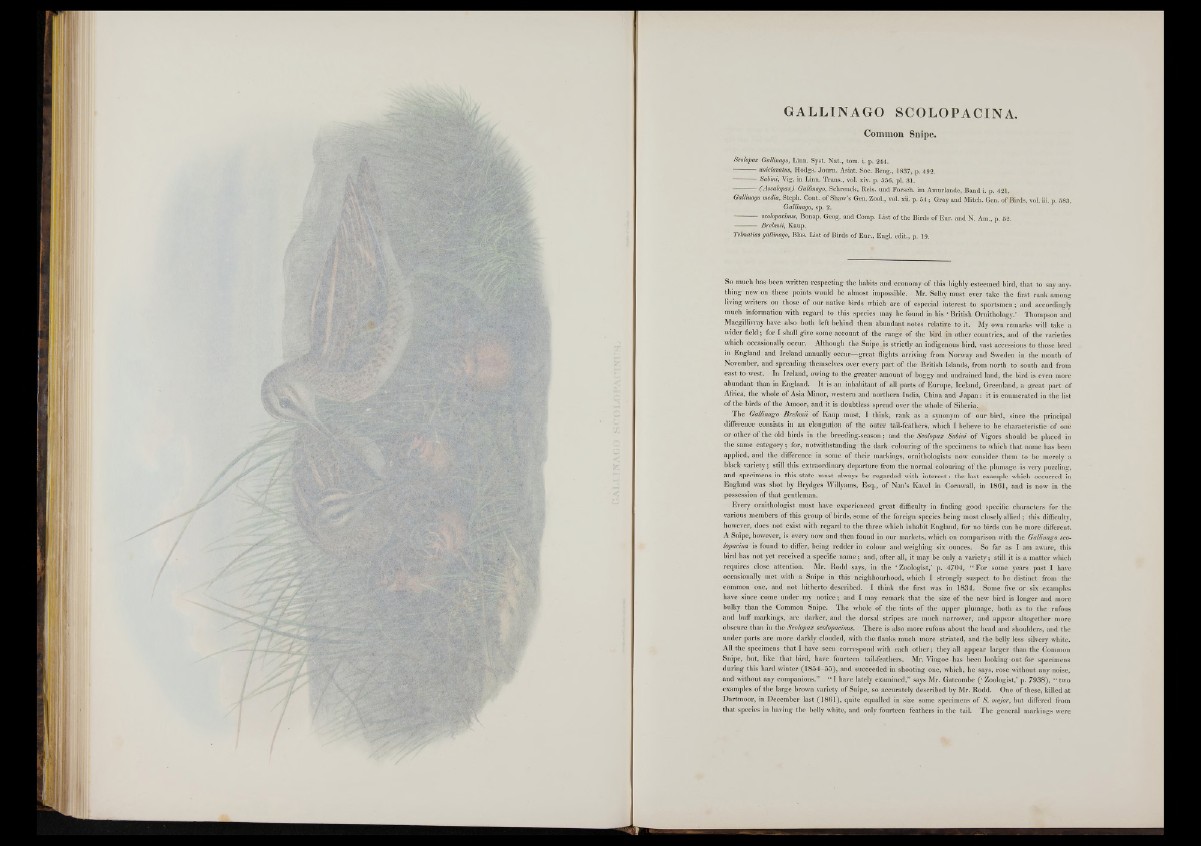
GALLINAGO SCOLOPACINA.
Common Snipe.
Scolopax Gallmago, Linn. Syst. Nat., tom. i. p. 244.
----------miclavatus, Hodgs. Journ. Asiat. Soc. Beng., 1837, p. 492.
— ;------- Sabini, Vig. in Linn. Trans., vol. xiv. p. 556, pi. 31.
— — (AscalopaxJ Gallinago, Schrenck, Reis, und Forsch. im Amurlande, Band i. p. 421.
Gallinago media, Steph. Cont. of Shaw’s Gen. Zool., vol. xii. p. 54; Gray and Mitch. Gen. of Birds, vol. iii. p. 583,
Gallinago, sp. 2.
---------- scolopacinus, Bonap. Geog. and Comp. List of the Birds of Eur. and N. Am., p. 52.
---------- Brehmii, Kaup.
Telmatias gallinago, Bias. List of Birds of Eur., Engl, edit., p. 19.
So much has been written respecting the habits and economy of this highly esteemed bird, that to say anything
new on these points would be almost impossible. Mr. Selby must ever take the first rank among
living writers on those o f our native birds which are of especial interest to sportsmen; and accordingly
much information with regard to this species may be found in his ‘ B ritish Ornithology.’ Thompson and
Macgillivray have also both left behind them abundant notes relative to it. My own remarks will take a
wider field; for I shall give some account of the range of the bird in other countries, and of the varieties
which occasionally occur. Although the Snipe is strictly an indigenous bird, vast accessions to those bred
in England and Ireland annually occur—great flights arriving from Norway and Sweden in the month of
November, and spreading themselves over every p art of the British Islands, from north to south and from
east to west. In Ireland, owing to the greater amount o f boggy and undrained land, the bird is even more
abundant than in England. It is an inhabitant o f all parts o f Europe, Iceland, Greenland, a great part of
Africa, the whole o f Asia Minor, western and northern India, China and J a p a n : it is enumerated in the list
o f the birds of the A moor, and it is doubtless spread over the whole of Siberia.,
The Gallinago Brehmii o f Kaup must, I think, rank as a synonym o f our bird, since the principal
difference consists in an elongation o f the outer tail-feathers, which I believe to be characteristic o f one
o r other of the old birds in the breeding-season; and the Scolopax Sabini of Vigors should be placed in
the same category; for, notwithstanding the dark colouring o f the specimens to which that name has been
applied, and the difference in some o f their markings, ornithologists now consider them to be merely a
black variety; still this extraordinary departure from the normal colouring of the plumage is very puzzling,
and specimens in this state mnst always be regarded with in te re s t: the last example which occurred in
England was shot by Brydges Willyams, Esq., of Nan’s Kavel in Cornwall, in 1861, and is now in the
possession o f that gentleman.
Every ornithologist must have experienced great difficulty in finding good specific characters for the
various members o f this group of birds, some o f the foreign species being most closely allied; this difficulty,
however, does not exist with regard to the three which inhabit England, for no birds can be more different.
A Snipe, however, is every now and then found in our markets, which on comparison with the Gallinago sco-
lopacina is found to differ, being redder in colour and weighing six ounces. So far as I am aware, this
bird has not yet received a specific n ame; and, after all, it may be only a variety; still it is a matter which
requires close attention. Mr. Rodd says, in the ‘Zoologist,’ p. 4704, “ For some years past I have
occasionally met with a Snipe in this neighbourhood, which I strongly suspect to be distinct from the
common one, and not hitherto described. I think the first was in 1834. Some five or six examples
have since come under my n o tice; and I may remark that the size of the new bird is longer and more
bulky than the Common Snipe. The whole o f the tints o f the upper plumage, both as to the rufous
and buff markings, are darker, and the dorsal stripes are much narrower, and appear altogether more
obscure than in the Scolopaoo scolopacinus. There is also more rufous about the head and shoulders, and the
under parts are more darkly clouded, with the flanks much more striated, and the belly less silvery white.
All the specimens that I have seen correspond with each o th e r; they all appear larger than the Common
Snipe, but, like that bird, have fourteen tail-feathers. Mr. Vingoe has been looking out for specimens
during this hard winter (1 8 5 4 -5 5 ), and succeeded in shooting one, which, he says, rose without any noise,
and without any companions.” “ I have lately examined,” says Mr. Gatcombe ( ‘ Zoologist,’ p. 7938), “ two
examples of the large brown variety o f Snipe, so accurately described by Mr. Rodd. One o f these, killed at
Dartmoor, in December last (1861), quite equalled in size some specimens o f S . major, but differed from
that species in having the belly white, and only fourteen feathers in the tail. The general markings were